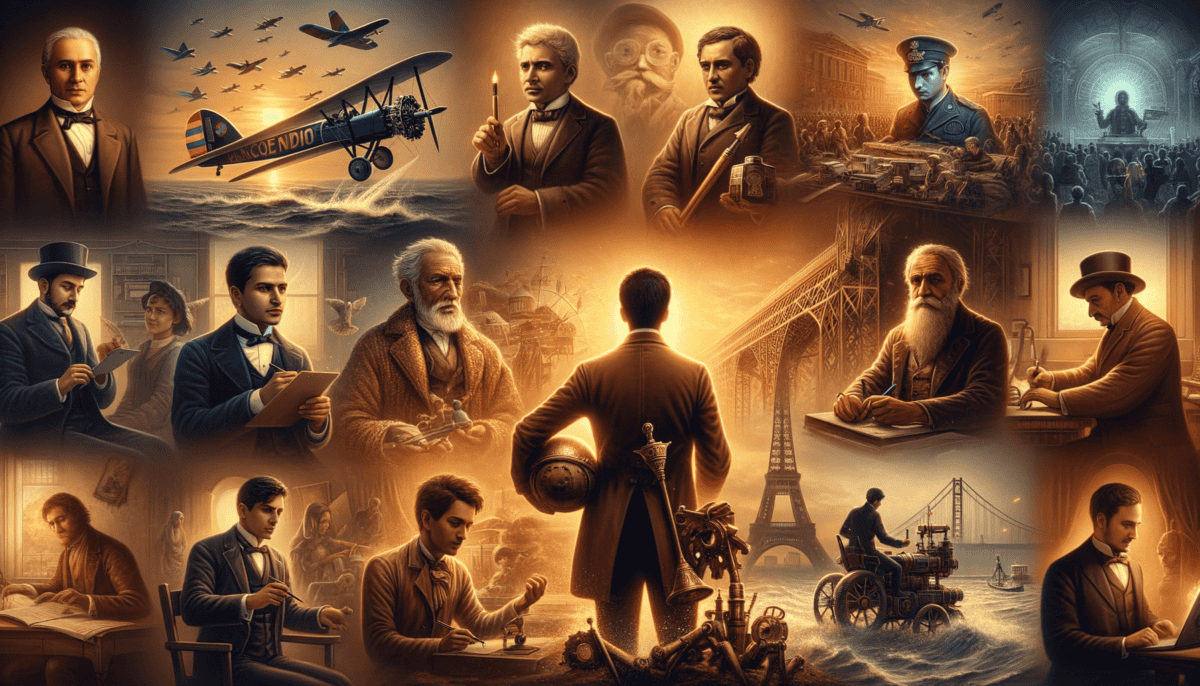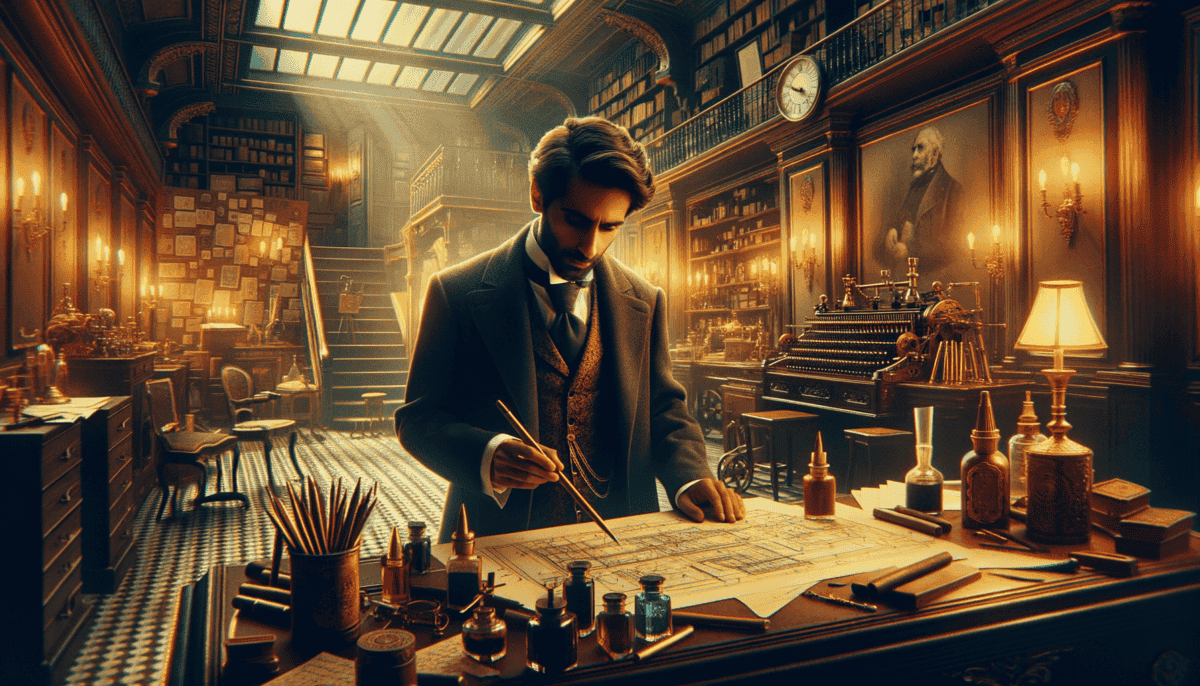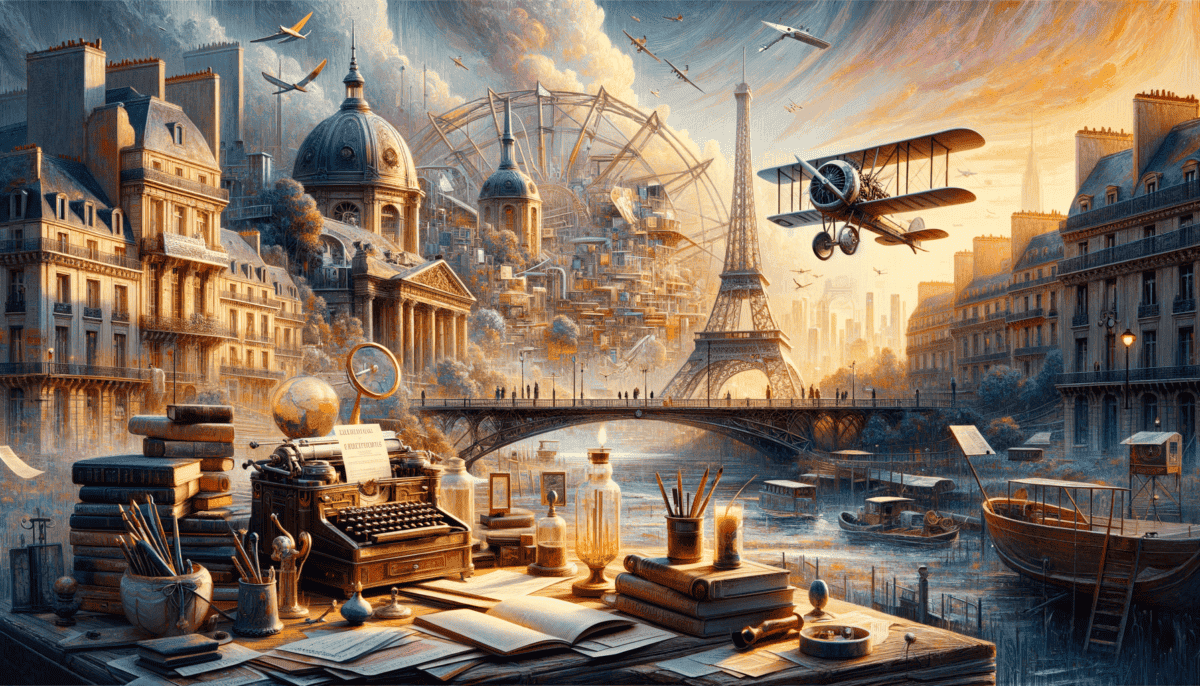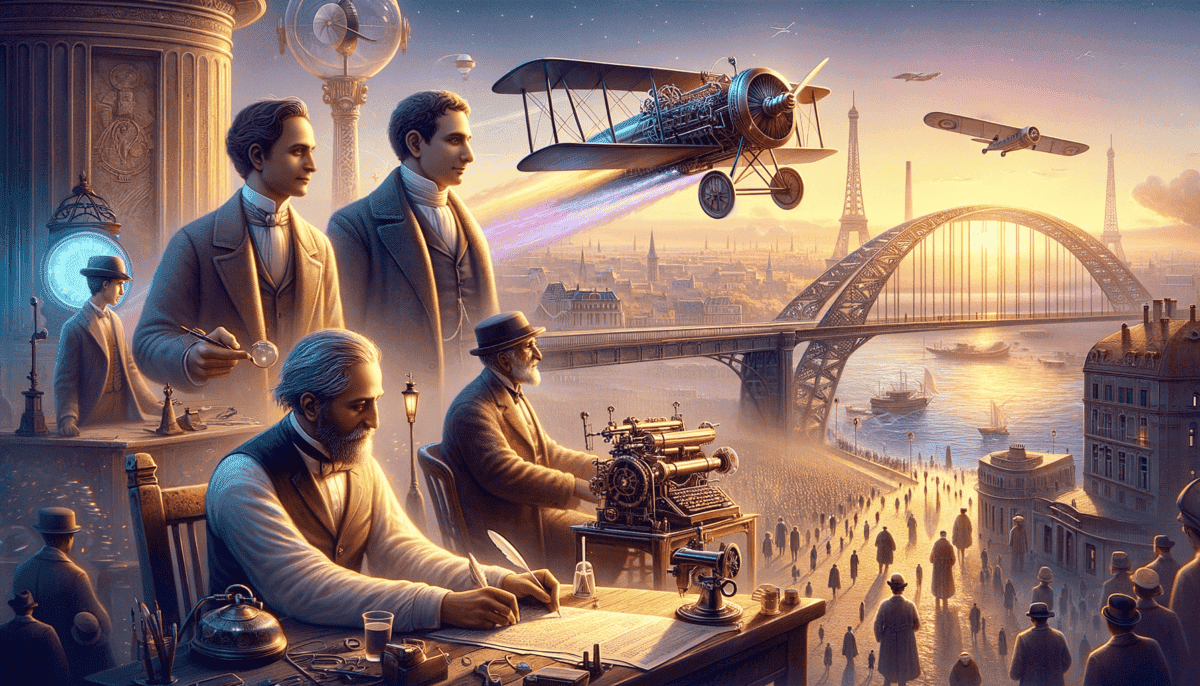A Young Dreamer Takes Flight
On a crisp morning in Bucharest, Romania, young Henri Coandă pressed his nose against his bedroom window. The year was 1892, and the ten-year-old boy watched birds soar through the sky with wonder in his eyes.
"Papa, why can't people fly like birds?" Henri asked his father, who was a general in the Romanian army.
His father laughed. "People aren't meant to fly, Henri. Keep your feet on the ground."
But Henri couldn't stop dreaming. He spent hours watching birds, studying how their wings moved through the air. While other kids played with toys, Henri built tiny machines from wood and metal scraps he found around his house.
The First Spark
One day, Henri made a paper airplane that flew differently from others. Instead of going straight, it curved and danced in the air. His eyes grew wide with excitement.
"Look what I made!" he shouted to his mother, who smiled at his enthusiasm.
"That's wonderful, dear," she said, "but please don't forget your studies."
A Different Kind of Student
At school, Henri wasn't like other students. While they read books about history and geography, he drew pictures of flying machines in his notebook. His teachers often found him daydreaming about inventions.
"Young man," his math teacher said one day, "what are you drawing now?"
Henri held up his notebook proudly. "It's a machine that will help people fly!"
The other students laughed, but Henri didn't mind. He knew in his heart that someday, his dreams would take off.
The Steam Engine Experiment
When Henri was twelve, he built his first real invention – a tiny steam-powered toy car. He used old tin cans, wire, and parts from broken clocks.
"It works!" he shouted as the little car puttered across the floor.
His father shook his head. "Henri, you should focus on military training instead of these toys."
But Henri's mother saw something special in her son's eyes. She gave him a warm hug and whispered, "Keep inventing, my little genius."
The Power of Wind
One windy afternoon, Henri noticed how leaves swirled in specific patterns. He grabbed his notebook and started drawing what he saw. This observation would later help him understand something very important about how air moves.
"There's a pattern here," he muttered to himself. "The air… it likes to follow curves!"
Little did anyone know that this curious boy would grow up to create something that would change the way people thought about flight forever. His dreams weren't just dreams – they were the beginning of an amazing journey that would make history.
As night fell over Bucharest, Henri sat at his desk, still drawing and planning. The candle flame flickered, casting shadows on his wall that danced like the birds he loved to watch. Tomorrow would bring new ideas, new experiments, and new chances to chase his dreams of flight.
Dreams Take Shape
The halls of the Military School in Iași echoed with whispers as young Henri Coandă walked past. At sixteen, he was different from his fellow students – his mind always racing with ideas about flying machines.
“Look at the dreamer,” some students would say. But Henri didn’t mind. He was too busy sketching designs in his notebook during breaks.
The First Big Step
One morning, Henri’s mathematics teacher found him working on complex calculations.
“What’s this, Coandă?” the teacher asked, picking up a drawing.
“It’s a device that uses hot air to create movement, sir,” Henri explained eagerly. “I call it a reaction motor!”
Off to Paris
In 1905, Henri’s life changed forever. He got the chance to study in Paris, the city of lights and innovation! His father wasn’t happy about it.
“Engineering? Instead of becoming a soldier?” his father frowned. “You’re throwing away your future!”
But Henri knew better. “I’m following my destiny, Papa. I will make you proud.”
The Big Invention
In Paris, Henri worked day and night on his biggest dream yet – the Coandă-1910. It wasn’t just any airplane. It was special because it used a new type of engine he invented.
“What makes your plane different?” reporters asked at a big air show in Paris.
Henri smiled proudly. “It doesn’t need propellers! It uses hot air to move – like a jet!”
The Test Flight
On a cold December morning in 1910, Henri prepared to test his invention. His hands shook with excitement as he started the engine.
The plane roared to life! But something unexpected happened. The hot air from the engine created strange effects Henri hadn’t planned for. The plane moved differently than he expected.
“Look out!” someone shouted.
Henri managed to stop the test safely, but he learned something very important that day. He discovered what scientists now call “the Coandă effect” – how air flows around curved surfaces.
Never Give Up
Many people thought Henri had failed, but he knew better. He kept working on his ideas. He wrote in his diary that night:
“Today wasn’t a failure. It was a discovery. Sometimes the best inventions come from unexpected places.”
Scientists didn’t believe Henri at first. They said his ideas about air flow were impossible. But Henri kept working, kept studying, and kept believing in his dreams.
As the sun set over Paris, Henri sat at his desk, just like he used to do as a boy in Bucharest. But now his drawings were bigger, his dreams were stronger, and his determination was unstoppable. He knew that tomorrow would bring new chances to prove that anything is possible if you believe in yourself.
Building Dreams in Steel
The mighty Danube River flowed beneath the morning sun as Anghel Saligny stood on its banks. He held his worn notebook, filled with drawings of what would become Romania’s greatest bridge.
“Papa, why do we need such a big bridge?” asked his young daughter, Maria, standing beside him.
“Because, little one,” Anghel smiled, “bridges connect people. They bring families together and help towns grow.”
A Big Challenge
Building the King Carol I Bridge wasn’t easy. Many people said it couldn’t be done. The Danube was wide and strong, and no one had built such a long bridge in Romania before.
Anghel worked with his team every day. They used new ways to build with steel that no one had tried before.
Smart Solutions
“The water is too deep!” worried one worker.
“Then we’ll make special boxes to work underwater,” Anghel replied calmly. He invented special tools just for this bridge.
“Every problem has a solution if you think hard enough.”
Racing Against Nature
The weather didn’t always help. Strong winds and rain made work difficult. But Anghel had a clever plan.
“See how birds build their nests?” he explained to his workers. “They make them strong enough to handle any storm. Our bridge will be just as smart!”
• Used special Romanian steel
• Had five big spans
• Took 4 years to build
• Connected two important regions
Testing Day
When the bridge was finally ready, Anghel did something that shocked everyone. He stood under the bridge as twelve loaded trains crossed over it!
“Why did you do that, Mr. Saligny?” a reporter asked.
Anghel smiled proudly. “Because I trust my work. I wanted to show everyone else they could trust it too.”
A Dream Come True
On September 14, 1895, King Carol I came to open the bridge. People from all over Romania came to see it.
“This bridge is more than steel and rivets,” Anghel told the crowd. “It’s proof that Romanian engineers can do amazing things!”
Little Maria tugged at her father’s sleeve. “Papa, you built the biggest bridge in Europe!”
“No, sweetheart,” he corrected gently. “We built it. All of Romania built it together.”
More Than Just a Bridge
The King Carol I Bridge became famous around the world. It showed everyone that Romanian builders could do great things. Even today, people still talk about how Anghel Saligny changed the way bridges are built.
As the sun set that evening, Anghel watched boats pass under his bridge. He thought about all the people who would use it, all the families it would bring together, and all the young engineers it would inspire.
“Every bridge,” he wrote in his diary, “is a story of hope, connecting not just places, but dreams.” ⭐
The Power of the Pen
️ Paris was bustling with excitement in 1827. Petrache Poenaru walked through the crowded streets, his mind racing with ideas. He was tired of stopping to dip his quill in ink every few words while writing.
“There must be a better way,” he muttered, watching ink drip from his quill onto his notebook.
A Messy Problem
Petrache was a teacher from Romania studying in Paris. He loved to write, but ink-stained fingers and blotchy papers were driving him crazy!
“Why can’t the ink just flow when we need it?” asked Marie, his young French neighbor.
“That’s exactly what I’m trying to figure out!” Petrache smiled.
The Big Idea
One day, while watching children play with quills, Petrache had an amazing thought. What if he could store ink inside the pen?
“Sometimes the simplest ideas are the best ones!”
He started experimenting in his tiny apartment. His first tries were quite messy!
Trial and Error
“Oh no, not again!” Petrache laughed as ink spurted everywhere. His cat, Luna, now had blue spots!
But he didn’t give up. Each failure taught him something new.
• Made a hollow barrel
• Added a tiny ink tank
• Created a special tip
• Tested different inks
The Big Day
Finally, after months of work, Petrache had done it! He called his invention the “plume portable sans fin” – the never-ending portable pen.
“Look, Marie!” he demonstrated. “No more ink pots needed!”
“It’s like magic!” she gasped, watching him write smoothly across the page. ✨
Going to the Patent Office
On May 25, 1827, Petrache walked nervously into the French Patent Office.
“This will change how everyone writes,” he explained to the patent officer.
The officer tested the pen. His eyes widened in amazement. “Monsieur Poenaru, this is brilliant!”
News Spreads Fast
Soon, everyone wanted to try Petrache’s fountain pen. Students loved not having to carry ink bottles. Writers could work faster than ever before.
“You’ve made writing fun!” said Marie, showing off her neat handwriting.
A Gift to the World
Petrache’s invention spread across Europe. Other inventors made improvements, but his basic idea remained the same.
“What makes you most proud?” a reporter asked years later.
“That children everywhere can write their stories without getting covered in ink,” Petrache smiled. “That’s worth more than all the money in the world.”
Back in his room that night, Petrache wrote in his journal using his special pen. “Sometimes,” he wrote, “the best inventions come from solving everyday problems.”
As he closed his journal, he imagined millions of people using fountain pens to write their own stories, just like he was writing his.
The Mind Behind the Machine
In a quiet Romanian village in 1902, Ștefan Odobleja sat under an apple tree, watching leaves dance in the wind. He wondered why everything in nature seemed connected, like a giant puzzle.
A Curious Mind
“Why does one thing always lead to another?” young Ștefan asked his mother.
“That’s just how the world works, dear,” she replied, not knowing her son would one day explain exactly how.
The Big Question
As Ștefan grew up, he became a doctor. But his mind kept thinking about bigger questions.
“The human brain is like a amazing machine,” he told his friend Ioan. “It takes information in, thinks about it, and makes decisions.”
“Just like your mother’s cooking!” Ioan laughed. “She takes ingredients, thinks about the recipe, and makes delicious soup!”
A New Way of Thinking
“Everything is connected, like a giant web of thoughts and actions!”
Ștefan started writing down his ideas. He called his new science “cybernetics” – the study of how things work together.
• Brains work like machines
• Everything is connected
• Actions cause reactions
• Systems need feedback
• Information flows like water
Drawing the Future
In his notebook, Ștefan drew pictures of machines that could think like humans. People thought he was silly.
“Machines that think? Impossible!” they said.
But Ștefan kept working. He knew he was onto something big.
The Big Book
In 1938, Ștefan finished his special book called “Psychology consonantista.” It was full of ideas about how minds and machines work.
“This book will help people understand the future,” he told Ioan.
Ahead of His Time
Years later, when real computers were invented, people realized Ștefan had been right all along!
“How did you know?” scientists asked him.
“I just watched how nature works,” he smiled. “Everything is connected, just like I always said.”
A Vision Comes True
Today, we use computers and smartphones that work just like Ștefan imagined. They take information in, think about it, and give us answers.
“Dr. Odobleja,” a young student asked, “what’s next for computers?”
“The future is like a garden,” he replied. “We plant ideas today that will grow into amazing things tomorrow.”
Seeds of Tomorrow
As night fell, Ștefan sat at his desk, drawing more pictures of thinking machines. He knew his ideas would help build a better future.
“Every connection matters,” he wrote in his journal. “Just like stars in the sky, we’re all part of something bigger.” ⭐
Building Tomorrow’s Dreams
The sun rose over Romania, painting the sky in brilliant colors. Four amazing stories of invention had changed the world forever.
A Special Meeting
In a beautiful museum in Bucharest, pictures of Henri Coandă’s flying machine, Anghel Saligny’s mighty bridge, Petrache Poenaru’s fountain pen, and Ștefan Odobleja’s thinking machines lined the walls.
The Magic of Ideas
A group of excited children pressed their faces against the glass cases. Their teacher, Ms. Elena, smiled at their wonder.
“Each inventor started just like you,” she said. “With big dreams and lots of questions.”
“Dreams are like seeds. If you water them with hard work, they grow into amazing things!”
Connecting the Dots
Little Maria raised her hand. “But how did they know their ideas would work?”
“They didn’t,” Ms. Elena replied. “They just believed and kept trying. That’s what makes them special.”
• Never give up on your dreams
• Keep asking questions
• Learn from mistakes
• Share your ideas
• Believe in yourself
The Next Chapter
As the children walked through the museum, their eyes sparkled with possibility. Each display sparked new questions and ideas.
“I want to build flying cars!” shouted Alex.
“I’m going to make robots that help people!” added Sofia.
A Global Impact
Today, planes use Coandă’s discoveries to fly better. Bridges stand strong thanks to Saligny’s ideas. People write with pens inspired by Poenaru. Computers work using principles Odobleja imagined.
The Future Calls
Ms. Elena gathered the children near a window overlooking the city. “Look out there,” she said. “The next great invention is waiting to be discovered.”
“By who?” asked Maria.
“Maybe by you,” Ms. Elena winked. “Romania’s spirit of invention lives in all of us.”
A New Generation
That evening, children across Romania pulled out notebooks, drew pictures, and built models. Each one carried a spark of the same magic that inspired the great inventors.
“Remember,” Ms. Elena had told them, “every big idea starts with a simple question: What if?”
The Dream Lives On
As stars twinkled over Romania, new dreams took flight. The story of these inventors wasn’t ending – it was just beginning again, in the hearts and minds of tomorrow’s creators. ⭐
Somewhere, a child looked up at those same stars and wondered, “What can I invent to make the world better?”
And just like that, the next great Romanian invention began to take shape.






